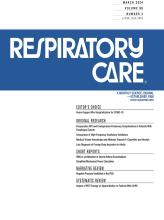This article requires a subscription to view the full text. If you have a subscription you may use the login form below to view the article. Access to this article can also be purchased.
Volume targeting in high-frequency oscillatory ventilation (HFOV) reduces CO2 variability and allows effective ventilation with very small tidal volumes (VT).1 Using volume targeting during HFOV requires the clinician to think differently about how to achieve the desired change in rate of CO2 clearance (also known as CO2 diffusion coefficient [DCO2]), which is an index of ventilation and is incorporated as one of the displayed measurement values on modern hybrid ventilators.2 DCO2 during HFOV is calculated as DCO2 = frequency × (VT during HFOV [VThf]).2 VThf thus has a greater impact on CO2 elimination in HFOV compared to conventional mechanical ventilation.3 During volume-targeted HFOV, an increase in frequency will increase DCO2 as the ventilator adjusts the amplitude to maintain the set VThf. In contrast, during HFOV without volume targeting, an increase in frequency will result in lower VThf without any adjustment of the amplitude.2,4 Modern hybrid ventilators that can deliver both conventional mechanical ventilation and HFOV incorporate proximal flow sensors to enable the measurement of VT so as to deliver volume-targeted modes.4 In …
Correspondence: Herng Lee Tan MSc RRT RRT-ACCS RRT-NPS, Respiratory Therapy Service, Allied Health Specialties, KK Women’s and Children’s Hospital Singapore, 100 Bukit Timah Road, Singapore 229899. E-mail: tanhernglee{at}yahoo.com
Pay Per Article - You may access this article (from the computer you are currently using) for 1 day for US$30.00
Regain Access - You can regain access to a recent Pay per Article purchase if your access period has not yet expired.







